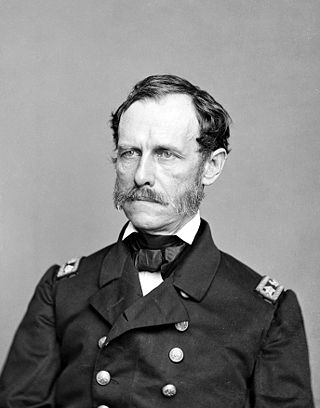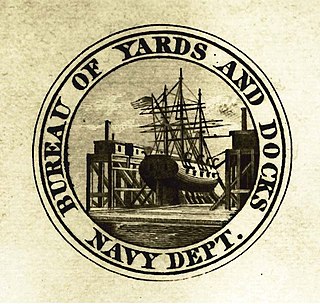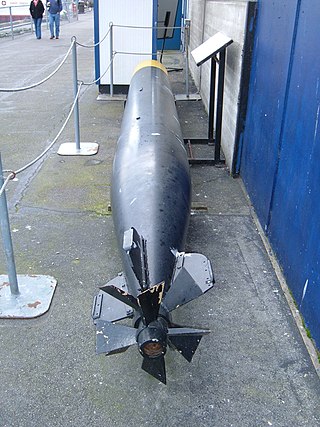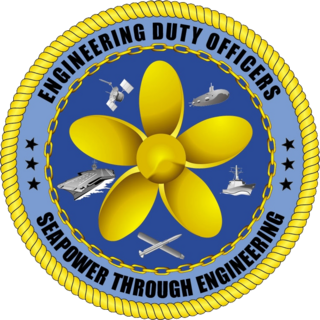External links
![]() This article incorporates public domain material from websites or documents of the National Archives and Records Administration .
This article incorporates public domain material from websites or documents of the National Archives and Records Administration .
The Bureau of Ordnance (BuOrd) was a United States Navy organization, which was responsible for the procurement, storage, and deployment of all naval weapons, between the years 1862 and 1959.
Established by an act of Congress, on July 5, 1862 (12 Stat. 510). As part of the department of the Department of the navy. which transferred the hydrographic functions of the Navy's Bureau of Ordnance and Hydrography (1842–1862) to the newly established Bureau of Navigation.
During the early 20th century, BuOrd became involved in the development of aerial weapons. This often led to friction with the Bureau of Aeronautics (BuAer), which had responsibility for the development of Naval aircraft. BuAer's work on "pilotless aircraft," or drones, conflicted with BuOrd's development of guided missiles. After World War II, the Navy examined ways to improve coordination between the two bureaus; ultimately, the decision was made to merge the two organizations into a new bureau, to be known as the Bureau of Naval Weapons (BuWeps). [1]
It was heavily criticized during the Second World War for its failure to quickly remedy the numerous issues with the Mark 14 torpedo which had an over 70% dud rate.
BuOrd was disestablished by Congress by an act of August 18, 1959 (73 Stat. 395), and its functions were transferred to the newly established Bureau of Naval Weapons. BuAir merged with BuOrd to form BuWeps. BuWeps, in turn, was disestablished in 1966 when the Navy overhauled its materiel organization, and was replaced with the Naval Ordnance Systems Command (NAVORD) and the Naval Air Systems Command (NAVAIR). [1] Other systems commands at the time included the Naval Ship Systems Command (NAVSHIPS) and the Naval Electronics Systems Command (NAVELEX). Ship and submarine ordnance functions fell under the new Naval Ordnance Systems Command while air ordnance stayed with the Naval Air Systems Command. In July 1974, the Naval Ordnance Systems Command and Naval Ship Systems Command merged to form the Naval Sea Systems Command (NAVSEA). Traditional Naval Ordnance functions are now conducted at the Naval Surface Warfare Centers which fall under the command of Naval Sea Systems Command.
![]() This article incorporates public domain material from websites or documents of the National Archives and Records Administration .
This article incorporates public domain material from websites or documents of the National Archives and Records Administration .

John Adolphus Bernard Dahlgren was a United States Navy officer who founded his service's Ordnance Department and launched significant advances in gunnery.

William Sterling Parsons was an American naval officer who worked as an ordnance expert on the Manhattan Project during World War II. He is best known for being the weaponeer on the Enola Gay, the aircraft which dropped an atomic bomb on Hiroshima, Japan, in 1945. To avoid the possibility of a nuclear explosion if the aircraft crashed and burned on takeoff, he decided to arm the bomb in flight. While the aircraft was en route to Hiroshima, Parsons climbed into the cramped and dark bomb bay, and inserted the powder charge and detonator. He was awarded the Silver Star for his part in the mission.
The Bureau of Aeronautics (BuAer) was the U.S. Navy's material-support organization for naval aviation from 1921 to 1959. The bureau had "cognizance" (i.e., responsibility) for the design, procurement, and support of naval aircraft and related systems. Aerial weapons, however, were under the cognizance of the Navy's Bureau of Ordnance (BuOrd).

The United States Naval Surface Warfare Center Dahlgren Division (NSWCDD), named for Rear Admiral John A. Dahlgren, is located in King George County, Virginia, in close proximity to the largest fleet concentration area in the Navy. NSWCDD is part of the Naval Surface Warfare Centers under the Naval Sea Systems Command (NAVSEA). NSWCDD was initially established 16 October 1918 as a remote extension of Maryland's Indian Head Proving Ground used for testing naval guns. The Dahlgren site was named the Lower Station, Dahlgren Naval Proving Ground when it first opened. The location on the Potomac River was specifically chosen for the development of a long ballistic test range on the Potomac River, required for the testing of modern, high-powered munitions.
The Bureau of Naval Weapons (BuWeps) was part of the United States Navy's material organization between 1959 and 1966, with responsibility for procurement and support of naval aircraft and aerial weapons, as well as shipboard and submarine naval weapons. The bureau was established August 18, 1959, by an Act of Congress. The Act merged the Bureau of Aeronautics (BuAer), which had responsibility for naval aircraft and related systems, and the Bureau of Ordnance (BuOrd), which had responsibility for naval weapons.
The Bureau of Construction and Repair (BuC&R) was the part of the United States Navy which from 1862 to 1940 was responsible for supervising the design, construction, conversion, procurement, maintenance, and repair of ships and other craft for the Navy. The bureau also managed shipyards, repair facilities, laboratories, and shore stations.
The "bureau system" of the United States Navy was the Department of the Navy's material-support organization from 1842 through 1966. The bureau chiefs were largely autonomous, reporting directly to the Secretary of the Navy and managing their respective organizations without the influence of other bureaus. In 1966, the bureaus were gradually replaced by unified commands reporting to the Chief of Naval Operations.
Commodore was an early title and later a rank in the United States Navy, United States Coast Guard and the Confederate States Navy, and also has been a rank in the United States Public Health Service Commissioned Corps and the National Oceanic and Atmospheric Administration Commissioned Officer Corps and its ancestor organizations. For over two centuries, the designation has been given varying levels of authority and formality.

Vice Admiral Paul David Stroop was an officer of the United States Navy and a Naval Aviator. He held numerous high-ranking staff positions in aviation from the 1930s onward, including World War II service on the staff of the Chief of Naval Operations. During the late 1940s and early 1950s, he held various sea commands. From 1959 to 1962, he oversaw the development of the Navy's aerial weapons, including early guided missiles, as chief of the Bureau of Naval Weapons. During the later 1960s, he commanded Naval air forces in the Pacific.
The United States Navy's Bureau of Ships (BuShips) was established by Congress on 20 June 1940, by a law which consolidated the functions of the Bureau of Construction and Repair (BuC&R) and the Bureau of Engineering (BuEng). The new bureau was to be headed by a chief and deputy-chief, one selected from the Engineering Corps (Marine Engineer) and the other from the Construction Corps (Naval Architect). The chief of the former Bureau of Engineering, Rear Admiral Samuel M. "Mike" Robinson, was named BuShips' first chief, while the former chief of the Bureau of Construction & Repair, Rear Admiral Alexander H. Van Keuren, was named as BuShips' first Deputy-Chief. The bureau's responsibilities included supervising the design, construction, conversion, procurement, maintenance, and repair of ships and other craft for the Navy; managing shipyards, repair facilities, laboratories, and shore stations; developing specifications for fuels and lubricants; and conducting salvage operations.

The Bureau of Yards and Docks was the branch of the United States Navy responsible from 1842 to 1966 for building and maintaining navy yards, drydocks, and other facilities relating to ship construction, maintenance, and repair.

The Mark 14 torpedo was the United States Navy's standard submarine-launched anti-ship torpedo of World War II. This weapon was plagued with many problems which crippled its performance early in the war. It was supplemented by the Mark 18 electric torpedo in the last two years of the war. From December 1941 to November 1943 the Mark 14 and the destroyer-launched Mark 15 torpedo had numerous technical problems that took almost two years to fix. After the fixes, the Mark 14 played a major role in the devastating blow U.S. Navy submarines dealt to the Japanese naval and merchant marine forces during the Pacific War.
The Bureau of Steam Engineering was a bureau of the United States Navy, created by the act of 5 July 1862, receiving some of the duties of the former Bureau of Construction, Equipment and Repair. It became, by the Naval Appropriation Act of 4 June 1920, the Bureau of Engineering (BuEng). In 1940 it combined with the Bureau of Construction and Repair (BuC&R) and became the Bureau of Ships (BuShips).

Admiral John Harold Sides was a four-star admiral in the United States Navy who served as commander in chief of the United States Pacific Fleet from 1960 to 1963 and was known as the father of the Navy's guided-missile program.
The systems commands, abbreviated as SysCom or SYSCOM, are the materiel agencies of the United States Department of the Navy, responsible for the design, construction, and maintenance of military systems such as ships, aircraft, facilities, and weapons. The systems commands replaced the Navy bureau system in 1966 and report to the Assistant Secretary of the Navy for Research, Development and Acquisition. The current Navy systems commands are:

An engineering duty officer (EDO) is a restricted line officer in the United States Navy, involved with the design, acquisition, construction, repair, maintenance, conversion, overhaul and disposal of ships, submarines, aircraft carriers, and the systems installed aboard. As of August 1, 2016, there are approximately 835 engineering duty officers on active duty in the U.S. Navy, representing approximately 2 percent of its active-duty commissioned officers.

The Naval Sea Systems Command (NAVSEA) is the largest of the United States Navy's five "systems commands," or materiel organizations. From a physical perspective, NAVSEA has four shipyards for shipbuilding, conversion, and repair, ten "warfare centers", the NAVSEA headquarters, located at the Washington Navy Yard, in Washington D.C., and other locations in 15 states and 3 overseas continents.

Commodore Submarine Service is a post in the Royal Navy which involves command of the Royal Navy Submarine Service. It evolved from the post of Inspecting Captain of Submarines in 1901 and would later evolve to become the post of Flag Officer Submarines in 1944.

Glenn Benson Davis was a highly decorated officer in the United States Navy with the rank of Vice Admiral. He distinguished himself as Commanding officer of battleship USS Washington during the Naval Battle of Guadalcanal in November 1942, when Washington sank the Japanese battleship Kirishima.